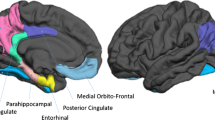Abstract
Since the first description of the case of Auguste Deter, presented by Alois Alzheimer, there has been an exponential increase of our knowledge regarding neuropathological, cellular, and molecular substrates of Alzheimer disease (AD). The concept of AD pathogenesis has evolved from a static, binary view discriminating cognitive normality from dementia towards a dynamic view that considers AD pathology as a long-lasting morbid process that takes place progressively over years, or even decades, before the first symptoms become apparent operating in a continuum between the two aforementioned extreme states.
Access provided by Autonomous University of Puebla. Download conference paper PDF
Similar content being viewed by others
Keywords
These keywords were added by machine and not by the authors. This process is experimental and the keywords may be updated as the learning algorithm improves.
Since the first description of the case of Auguste Deter, presented by Alois Alzheimer, there has been an exponential increase of our knowledge regarding neuropathological, cellular, and molecular substrates of Alzheimer disease (AD). The concept of AD pathogenesis has evolved from a static, binary view discriminating cognitive normality from dementia towards a dynamic view that considers AD pathology as a long-lasting morbid process that takes place progressively over years, or even decades, before the first symptoms become apparent operating in a continuum between the two aforementioned extreme states. Several biomarkers have been proposed to predict AD-related cognitive decline, initially in cases with mild cognitive impairment and more recently in cognitively intact individuals. These early markers define at-risk individuals that are thought to be at the preclinical phase of AD. However, the clinical meaning of this preclinical phase remains controversial. The fate of these cognitively intact individuals positive for some early AD biomarkers is still a matter of debate. Preclinical AD markers may represent a double-edge sword. On the one hand, they make it possible to define a group at risk for AD-type dementia (in terms of disease prevalence) but, on the other hand, this group may comprise an increased ratio of resistant individuals, which do not develop dementia despite substantial brain cerebral amyloidosis. Within the preclinical AD spectrum, a first group concerns presymptomatic cases that are positive for at least one amyloid marker (e.g., PiB-PET, low Aβ42 CSF level). All of these subjects could convert to MCI or AD-type dementia within 8–10 years. A second group includes cases with stable asymptomatic cerebral amyloidosis that will indefinitely remain cognitively stable, even though they have positive amyloid marker(s). Defining distinct biomarkers for these stable cases would enable more reliable predictions of clinical evolution at the individual level. Moreover, comparative analysis of these two groups could let us gain better insight into the nature of compensatory mechanisms as well as into the reasons of their failure that marks the beginning of AD-type dementia.
Author information
Authors and Affiliations
Corresponding author
Editor information
Editors and Affiliations
Rights and permissions
Copyright information
© 2015 Springer International Publishing Switzerland
About this paper
Cite this paper
Giannakopoulos, P. (2015). Searching for AD-Related Biological Vulnerability in Cognitively Intact People: A New Perspective for Mental Health. In: Vlamos, P., Alexiou, A. (eds) GeNeDis 2014. Advances in Experimental Medicine and Biology, vol 821. Springer, Cham. https://doi.org/10.1007/978-3-319-08939-3_2
Download citation
DOI: https://doi.org/10.1007/978-3-319-08939-3_2
Published:
Publisher Name: Springer, Cham
Print ISBN: 978-3-319-08938-6
Online ISBN: 978-3-319-08939-3
eBook Packages: Biomedical and Life SciencesBiomedical and Life Sciences (R0)



